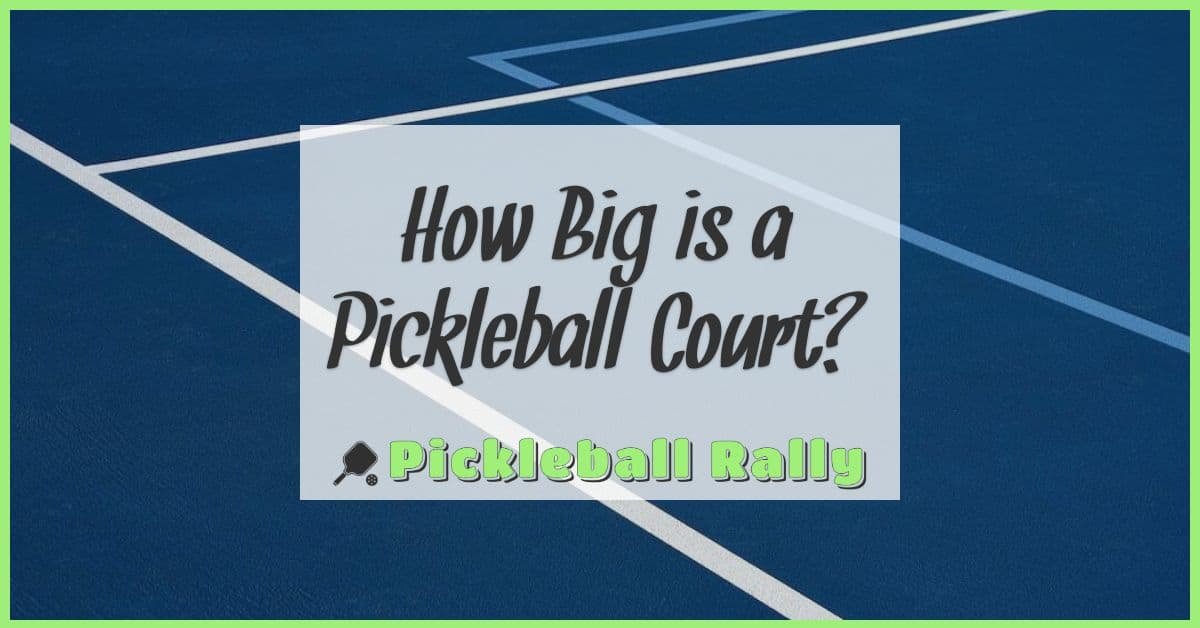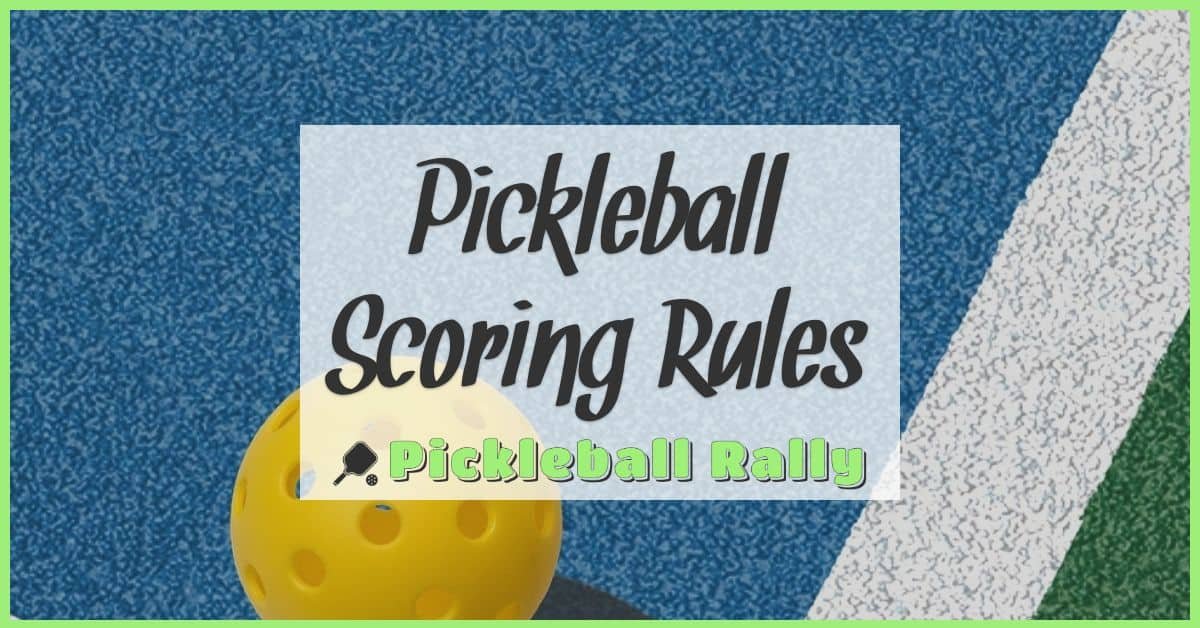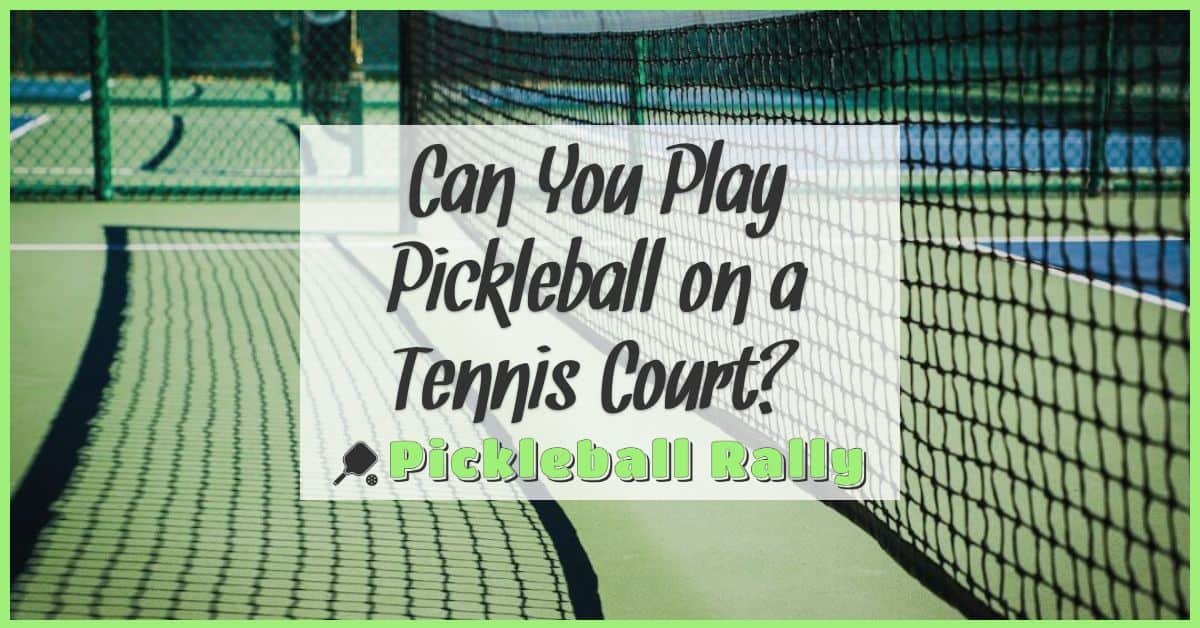You’re probably wondering, “how big is a pickleball court?” Well, you’re in the right place for answers. First and foremost, it’s important to note that the official size of a pickleball court is 20 feet wide by 44 feet long. This size standard applies to both singles and doubles play.
However, you might want to consider a few additional factors. For example, for ample space and safety, you should add a minimum buffer zone of at least 10 feet on each side and 21 feet for the baseline. This additional space is especially important if you’re planning to build your homemade court.
On top of the standard court dimensions, you might also want to account for the non-volley zone, also known as the “kitchen.” It extends 7 feet from the net on either side, creating a 14 x 20-foot zone where volleying is prohibited. Grasping these dimensions will not only help you understand the game better but also will assist in your strategy in mastering pickleball.
From the initial playing area to the extra space considerations, knowing the precise size of a pickleball court plays a crucial part in enjoying and excelling in the sport. With this helpful knowledge at your disposal, you’re setting yourself up for many wins on the pickleball court.

Dive Into Pickleball: Understanding the Game
Pickleball, ever heard of it? It’s a racket sport that’s grown immensely popular in the United States. A blend between tennis, badminton, and ping-pong, pickleball makes players return the ball over a net on a court of specific dimensions. Let’s delve into understanding the game and its intriguing dynamics.
The rules and the layout of a pickleball court are simple and navigable. You’ll need to grasp some basic dimensions and layouting rules to enhance your gameplay.
- Pickleball court: Think of a pickleball court as a badminton court on the top, but with the size of a doubles badminton court. The measurement? It’s 20 feet wide and 44 feet long.
- Service boxes: Each side of the court has two service boxes. They are each 10 feet wide and 15 feet long.
- Non-volley zone: In the pickleball world, you’ll often hear of something called the “kitchen.” That’s the non-volley zone in the pickleball court – a 7-foot zone on both sides of the net where the ball cannot be volleyed.
- The Net: Compared to a tennis net, a pickleball net is significantly smaller. The net’s height at the center is 34 inches and 36 inches at the posts.
| Items | Dimensions |
|---|---|
| Full Court | 20 feet x 44 feet |
| Service Boxes | 10 feet x 15 feet |
| Non-Volley Zone (Kitchen) | 7 feet each side |
| Net Height (Center) | 34 inches |
| Net Height (Post) | 36 inches |
Now, don’t just look at the numbers! Get your sporting gear, step into a pickleball court, and start feeling the game. With a bit of practice, you’ll soon embrace the nuances of this exciting sport and develop an appreciation for its technicalities. Remember, practice makes perfect. Time to grab your pickleball paddle and have some fun!
Breakdown of the Standardized Pickleball Court Size
Understanding the size of a pickleball court is essential to master the game. Whether you’re a curious beginner or an aspiring pro, we’ve got you covered. Pickleball courts, sporting a similar layout to a doubles badminton court, are standardized and specific in their measurements.
Let’s dissect the dimensions, shall we? The overall size of a pickleball court, including out-of-bounds areas, measures 20 feet by 44 feet. Now, you may wonder about the inner court space. The area where all the action happens, is often a rectangle 20 feet wide and 44 feet long. It’s divided equally into two 22 feet long rectangular service courts.
The key feature here is the “non-volley zone“. This 7 feet area extends from the net on both sides, often referred to as “The Kitchen”. Got it? No volleys are allowed here! These specific measurements ensure the game keeps its fast-paced and exhilarating rhythm.
Take a quick look at the measurements:
| Area | Measurement (feet) |
|---|---|
| Entire court | 20 by 44 |
| Playing area | 20 by 44 |
| Service courts | 20 by 22 |
| Non-volley zone (“The Kitchen”) | 7 by 20 |
Don’t be misled though – it’s not the size, but how you use it counts! A good player knows their court intimately. After all, strategies differ on different areas of the court. So, get used to the dimensions. Practice moving around, learn the spots. Remember, trial and error is key in learning to control your court space.
Are you installing your own court? Pay attention to the following recommendations:
- Clear Space: Have at least 5 feet clear space surrounding the court.
- Surface: Concrete or asphalt makes the best surfaces. But, even a grassy backyard can be put to good use.
- Orientation: East-West orientation helps avoiding sun in the eyes.
The more you play, the more familiar the court size will feel. You’ll soon tune into the rhythm of the game. So lace up those sneakers, grab a paddle, and hit the court – your pickleball adventures are just getting started!
Indispensable Pickleball Court Dimensions for Singles Play
Interested in setting up your own pickleball court? You’ve come to the right place. Regardless of whether you’re a pro or a casual player, you need a good grasp of the court dimensions for singles play. Not only will this knowledge help you set up your court, but it’ll also improve your understanding of the game itself.
First things first, let’s talk about the overall size of the court. A standard pickleball court measures 20 feet wide by 44 feet long. That’s the same size you’d see in doubles play – it’s one of the sport’s unique aspects.
| Measurement | Size |
|---|---|
| Width | 20 feet |
| Length | 44 feet |
However, the size isn’t the whole story. There are specific zones and lines within this area you’ll need to know. These include the non-volley zone, the service courts, and the baseline.
- The non-volley zone, also known as the kitchen, extends 7 feet from the net on either side. It’s a zone where volleys aren’t allowed!
- Each service court is a 15ft by 20ft sector, positioned on either side of the non-volley zone.
- The baseline stands as the furthest line from the net, marking the limit of the court.
| Part of the court | Size |
|---|---|
| Non-Volley Zone (Kitchen) | 7 feet |
| Service Court | 15ft by 20ft |
| Baseline | Full width of the court |
When serving in singles play, players serve diagonally across from their current position, switching sides with every point scored. It’s crucial to remember that the server must stay outside of the non-volley zone when serving.
All in all, understanding these dimensions and rules can give you the edge in your game! It’s vital to grasp these facts for optimal play and strategy. As with anything, practice makes perfect, so hit the court and apply your new-found knowledge.
How Does the Court Size Change for Doubles Play?
Stepping into the world of pickleball, you’ll notice that this sport is unique, especially when it comes to court sizes. Doubles play in pickleball brings with it a few interesting twists. You might be asking, does the court size change for doubles play? Well, let’s delve into that.
Pickleball court dimensions remain the same whether you’re playing singles or doubles. That’s right, your playground remains a rectangular area with a total size of 20 by 44 feet. However, there’s a twist. In doubles play, there’s a strategy to using this space more than in singles play.
Within the playground, you and your teammate should strategically utilize the ‘No-volley zone’. Also known as the kitchen, this 14-foot area (extending 7 feet on both sides from the net) becomes crucial during doubles play.
| Area Name | Dimension |
|---|---|
| Full Court | 20 by 44 feet |
| No-Volley Zone (Kitchen) | 14 feet (7 feet on each side) |
However, never underestimate the significance of the service boxes. In doubles, both players will serve except for the first service of a new game where only one partner serves. The boundaries change with each serve, alternating from right service court to left and so forth. This strategic change in serving turns the game into a whirl of well-planned shots and agile movement.
- Always serve diagonally.
- Initial bounce should be in the appropriate service box.
- Remember, service boxes alternate with each serve.
Navigating the vibrant, dynamic routine of doubles pickleball can be both fun and challenging. Remembering the little tricks of the trade—like maintaining the same court size but leveraging the space differently—can dramatically enhance your play. So, pack your enthusiasm, arm yourself with these insights and take on your next exciting game of pickleball!
Key Features of a Pickleball Court: More Than Just Size
When you think about a pickleball court, size is likely the first thing that comes to mind. However, there’s much more to these courts than just dimensions. Here, we’ll delve into the key features that go beyond mere size.
First off, pickleball courts are rectangular, similar to other racket sports like tennis or badminton. The dimensions? Regulation size dictates a length of 44 feet and width of 20 feet. Now let’s delve deeper and explore other elements that set these courts apart.
| Key Features | Size/Number |
|---|---|
| Length | 44 feet |
| Width | 20 feet |
| Service area | 15×10 feet |
| Non-volley zone | 7 feet |
As you can see, one unique feature of a pickleball court is the “non-volley zone”, also known as the ‘kitchen’. This is a 7-foot area on both sides of the net where volleying is not allowed. It encourages longer rallies and increases the challenge of the game – there’s something you won’t find in just any racket sport.
Added to that, another standout attribute is the “service area”. This area, stretching 15 feet in length and 10 feet in width, is where serves must land. Service violations are common for beginners so it’s an area you’ll want to master quickly.
Another unique factor? Pickleball courts have specific line markings. The sidelines, centerline, baseline, and non-volley zone lines are all clearly marked. If you’re looking to up your game, getting familiar with these markings is crucial.
Sure, size does matter in pickleball – but remember, courts are not just about dimensions. Aspects like the non-volley zone, service area, and line markings may seem minor, but they can dramatically impact your game. So, go ahead, step onto the court, and immerse yourself in the fascinating world of pickleball.
Comparing Pickleball to Other Racquet Sports: Size Matters
Let’s begin by painting a mental picture of what a pickleball court looks like. Imagine a badminton-sized court with a net slightly lower than that of a tennis court. The court dimensions, marked for Singles or Doubles play, mimic those of a badminton court – 20 feet wide by 44 feet long. What’s truly unique about the pickleball court, however, is its non-volley zone rules. This ‘kitchen’ area extends 7 feet on both sides of the net, restricting volley (hitting in the air, without letting the ball bounce) within this zone.
To put it into perspective, consider this: While pickleball court is a fraction of a tennis court size, it’s significantly larger than a squash or racquetball court.
| Racquet Sport | Court Size (in feet) |
|---|---|
| Pickleball | 20 x 44 |
| Tennis (Singles) | 27 x 78 |
| Squash | 21 x 32 |
| Racquetball | 20 x 40 |
Pickleball does indeed require less space compared to tennis or badminton, allowing more courts to fit in a comparable area. This particular feature makes pickleball more feasible in neighborhood settings where space availability may be limited.
Let’s consider court surface. Unlike the grass, clay, or hard surfaces used for tennis, pickleball games can easily set up on indoor wooden floors or outdoor hard courts. Flexibility in playing grounds places pickleball in a favorable position of being a versatile sport.
The following could influence your game and strategy:
- Close proximity to opponents in doubles play.
- Quick, reflex-driven exchanges at the net.
- Strategic shot placements over powerful, speed-driven shots due to court dimensions.
So yes, size does indeed matter. Whether you’re traditionally a tennis, badminton, squash, or racquetball player, stepping on the pickleball court will offer a unique challenge that taps into your competitive spirit. Each racquet sport requires a mix of similar yet distinct skills, and pickleball blends components from each to create a fast, fun, and strategic game.
Do-It-Yourself Approach: Building Your Own Pickleball Court
Embarking on a do-it-yourself project can be both challenging and rewarding, especially when it comes to creating your own pickleball court. That’s right, you read that well—it’s entirely possible to build your own court! Below, we’ll detail the steps and items you’ll need so you can hit the ground running with your building project.
Start with the measurements; an official pickleball court measures 20 by 44 feet for both doubles and singles play. This space needs to be completely flat, so this could mean some considerable groundwork is needed in your chosen area before proceeding. Here are a few key measurements to keep in mind:
| Measurement | Description |
|---|---|
| Total Court Size: 20 by 44 feet | Includes the out-of-bounds areas |
| Net Height: 36 inches at the sidelines, 34 inches at the center | Needs to be lower in the middle by 2 inches |
Got those measurements down? Good. Now, let’s gather the materials. Here’s your DIY court checklist:
- Ground smoothing items (like a level, rake, or rototiller)
- Tape measure and stakes for marking your court’s boundaries
- Concrete or asphalt, depending on your preference for the court surface
- Paint for the court lines
- Portable or permanent pickleball net
Once you’ve cleared and leveled the ground, follow your measurements and mark your court boundaries, including an additional 10 feet on each end for the out-of-bounds area. The standard color for pickleball courts is a bright blue for the playing area and a contrasting white for the lines and out-of-bounds, although you’re free to choose your own color scheme.
Laying the concrete or asphalt is the next step, potentially the most challenging part; it’s recommended to hire a professional for this if you’re uncertain. A smooth, flat surface is crucial for a good pickleball court. Then, using your measurements, paint on the lines for the serving areas, non-volley (or kitchen) areas, and the boundary lines.
Hooking up the net is your final step. It should hang 36 inches high on the ends and 34 inches high in the middle, perfectly following the international pickleball standard.
Remember, this isn’t a small weekend project, but with the right attitude and patience, you’ll be serving aces on your own court in no time. Happy building!
Making Adjustments: Adapting Spaces for Pickleball Play
You’re probably thinking about converting a space you have into a pickleball court or considering squeezing one into your new home layout plans. Either way, you need to know the court’s dimensions and how to adjust these correctly to fit your space.
First off, let’s talk about a regulation-sized pickleball court. The standard size is 20 feet wide and 44 feet long, which is the same as a doubles badminton court. The size of the courts allows for singles and doubles plays, making it a versatile sport for all enthusiasts.
| Court Size | Dimensions |
|---|---|
| Width | 20 feet |
| Length | 44 feet |
But what if your space isn’t quite that large? Flexibility and adaptability are pickleball’s middle names. When faced with space constraints, don’t worry! You can adjust the court size and still enjoy a spirited game of pickleball.
- In smaller spaces, a court size of 17 feet by 33 feet is often used for recreational play.
- You may also reduce the size proportionately keeping the ratio similar, but remember, the adequacy of space for playing should be your top priority.
Remember, it’s not only about length and width. Your court should also allow enough ‘out of bounds’ space. At least 10 feet on all sides is ideal, but if that’s not possible, you’re still in luck. The minimum is 5 feet, preventing accidents as well as heated “was it in or out?” debates.
| Surrounding Clearance | Minimum | Ideal |
|---|---|---|
| All sides | 5 feet | 10 feet |
Finally, the net height, an often-overlooked aspect of a pickleball court’s dimensions. You’ll want an official height of 36 inches at the sidelines and 34 inches in the middle. This slight dip in the center adds an interesting tactical layer to the game.
| Net | Height |
|---|---|
| Sidelines | 36 inches |
| Middle | 34 inches |
In this manner, you can adapt a pickleball court to fit your space, making any necessary adjustments. By ensuring correct dimension proportions, even a compact court can offer a super fun game of pickleball, suitable for your needs without compromising the games’ spirit and charm.
Conforming to Official Regulations: The Importance of Court Size
A lot rides on your understanding of pickleball court dimensions. Getting it right is critical to honing your gameplay and ensuring fair play. Official regulations stipulate specific measurements for a standard pickleball court. Let’s delve into these crucial size guidelines, shall we?
The dimensions for a regulation pickleball court are similar to a doubles badminton court. The total dimensions of a pickleball court should be 20 feet wide by 44 feet long. This includes a 7-foot non-volley zone on either side of the court, often referred to as the “kitchen”. This area extends 7 feet from both sides of the net. The measurements for the court are thus quite specific and are as follows:
| Areas | Size |
|---|---|
| Full Court | 20 feet wide x 44 feet long |
| Non-volley zone (kitchen) | 7 feet from both sides of the net |
It’s also important to note that a 2-foot clearance on all sides of the court is generally considered good playing practice, although this isn’t strictly dictated in the rules.
When you adhere to these guidelines, you’ll find that your gameplay benefits immensely. Right sizing fosters accurate paddle swing, better mobility, and also ensures you’re practicing for standard tournament play. It’s simple: The right court size shapes better players.
Now you might be wondering about the importance of these precise dimensions. In pickleball, this precision helps determine gameplay. For instance, the non-volley zone has a pivotal role in controlling smash shots, which can be crucial in competitive games. Any discrepancies in the court structure can lead to a dis-balanced playing field.
Moreover, maintaining the standard pickleball court size is not merely about rules—it’s about ethics, game spirit, and being a good sport. Using the precisely measured court ensures equal opportunities for all players, fostering fair competition.
You’re on your way to mastering the intricacies of pickleball, but remember: conforming to the right court size is a great starting point. Now, grab your paddle and let the games begin!
Concluding Thoughts on Pickleball Court Size
Looking back at our discussion, it’s clear that pickleball court-sizing holds compelling considerations. Whether you’re building a private court in your backyard or planning a professional venue, understanding the size of a pickleball court is fundamental.
To recap, the total dimensions of a standard pickleball court are 20 feet by 44 feet. This size is inclusive of both singles and doubles play. No matter the style of the game, the court size does not alter. This information is vital to ensure you have enough space for a fully functional court.
Here are the standard pickleball court dimensions again:
| Court Type | Dimensions (feet) |
|---|---|
| Standard Court | 20 by 44 |
| Non-Volley Zone | 7 by 20 |
| Serving Area | 10 by 15 |
- Non-Volley Zone: Known as the ‘kitchen’, this area extends 7 feet on both sides of the net.
- Serving Area: The area on either side of the non-volley zone, measuring 15 feet in length by 10 feet wide.
Remember, spaces around the court must also be considered when planning its placement. You’ll require additional space for player movement, equipment storage, and potential fencing.
Pickleball court size is a crucial aspect of the game. It determines the playing dynamics and can significantly influence game strategy. We hope that our detailed guideline about pickleball court size has helped you plan your court dimensions better and optimize your game strategy. Now that you’re aware, you can confidently make informed decisions about playing or setting up a pickleball court.









